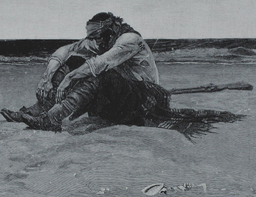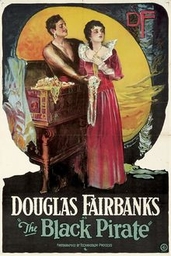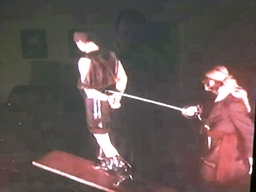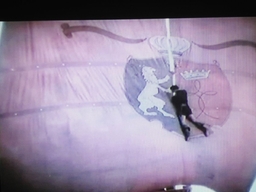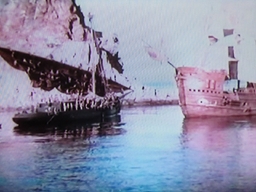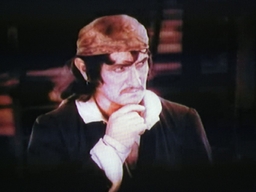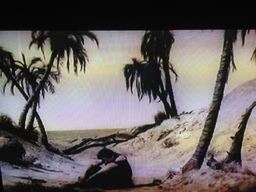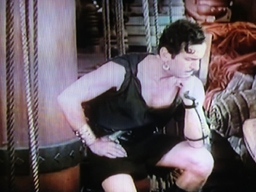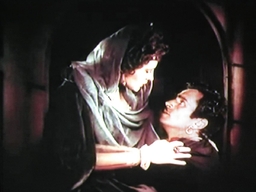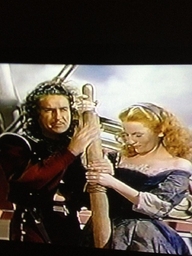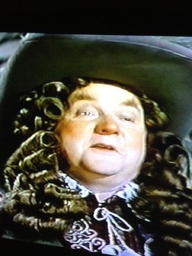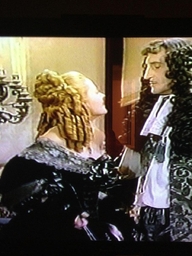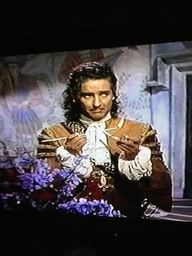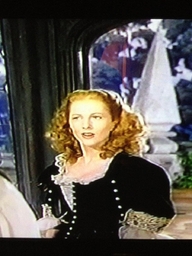-
Posts
652 -
Joined
-
Last visited
Content Type
Profiles
Forums
Events
Gallery
Everything posted by Daniel
-
From the album: The Black Pirate
-
From the album: The Black Pirate
-
Netflix also has Treasure Planet and Raiders of the Seven Seas on streaming.
-
From the album: The Black Pirate
-
From the album: The Black Pirate
-
From the album: The Black Pirate
-
From the album: The Black Pirate
-
From the album: The Black Pirate
-
From the album: The Black Pirate
-
I haven't seen it; I will watch it and post a review in the coming months, if I can get the DVD.
- 34 replies
-
- movies
- pirate art
-
(and 3 more)
Tagged with:
-
I would like to be able to put text and images next to each other, with text on the left side and images on the right side of the screen when I post my pirate movie reviews. It would look so much better to have the images next to the words instead of being trailed at the end of the review like I'm doing now. But I can't seem to make the BBCode do that. I Googled a few tricks for doing this, but I can't make them work. The post editor apparently doesn't understand [imgalign=right] or [floatright], for example, if those codes are even able to do what I'm trying to do. Is it even possible to put text and pictures next to each other on this board, and if so, how?
-
FRENCHMAN'S CREEK (1944) Directed by Mitchell Leisen. Featuring: Joan Fontaine, Arturo de Córdova, Basil Rathbone, Nigel Bruce, Cecil Kellaway, Ralph Forbes, Harold Maresch, Billy Daniel, Moyna MacGill, Patricia Barker, and David James. Daniels rating: 3½ out of 5. Synopsis: In 1668, wealthy Dona St. Columb dumps her oafish husband, taking her children from London to the seaside estate of Navron in Cornwall. There she meets Captain Aubrey, a French pirate who has been raiding the countryside from a ship anchored in a nearby river mouth, and sleeping in Navrons master bedroom, where he has fallen in love with her portrait on the wall. Dona is taken with Aubrey and joins him on his adventures, returning between times to Navron, her children, and her place as a lady. But how long can she keep her double life from being discovered? Evaluation: Frenchmans Creek is based on a novel by Daphne du Maurier, author of Rebecca, which became one of Alfred Hitchocks best and most famous movies. Looking at this movie alongside Rebecca, I feel pretty safe saying that du Maurier was obsessed with elegant, lonely manors with seacoast views and names like Manderley and Navron. I enjoyed Frenchmans Creek a lot more than I expected to. I was anticipating a limp, lifeless heroine bemoaning her fate in sterile black-and-white for a couple of hours. What I got was Joan Fontaine mmmm, Joan Fontaine lighting up the screen with verbal fireworks and, when necessary, kicking large quantities of butt. Fontaine nearly carries the movie all by herself. Her face is always full of intelligence and perception, accurately sizing up every character she meets, and she shows a palpable sense of excitement and love for adventure. Handed the worst, most stilted script youd ever want to crumple up and throw in the trash, she tosses off her lines effortlessly and naturally, making them sound almost like something an actual human being would say. But there's nothing she can do to save the film's ending, which simply ignores the most obvious solution to her problem. Unfortunately, Fontaines leading man is not a good match for her. Arturo de Córdovas Captain Aubrey has dashing good looks, but no style; all he can express is puppy-dog enthusiasm, and he stubs his toe on every third word of that same awful dialogue that Fontaine handles with such aplomb. Córdovas weaknesses hurt all the more because Captain Aubrey is hard to believe to start with. I mean, why does a French pirate leave his ship anchored for days in an English river mouth and cavort in the locals beds instead of striking fast and hard and then escaping out to sea or back to France? Couldnt you easily get captured that way? Oh, wait, he does get captured that way, almost as if the plot demanded it. Aubrey says that A slipshod pirate is a dead pirate, and serves him right. Sorry, Captain, but that means you. But Fontaine does get to face off with a nice, strong villain in Basil Rathbone. Rathbone is one of the greatest baddies of all time (pirate movie fans will remember him as Levasseur in Captain Blood), and here he's at his smarmy, sneering best as Lord Rockingham, the two-faced friend of Dona's husband Harry, his Captain Hook nose and steely baritone English accent full of menace. Best of all, Dona gets to defeat him herself, in a white-knuckle contest where both sides are playing for keeps. The supporting cast is a pleasant surprise too. Cecil Kellaway steals scene after scene as Dona's sly, beneficent servant William, while Nigel Bruce delivers his patented stuffed-shirt performance as Lord Godolphin. Ralph Forbes as Dona's husband Harry evokes sympathy; while a modern movie would surely have caricatured him as a wife-beating monster, here he appears as a well-meaning bumbler. Oh, and that sterile black-and-white photography I was expecting? Nowhere to be found. Frenchman's Creek is shot by George Barnes in rich Technicolor, with gorgeous sets everywhere you look. Two beautiful tall ships appear in the movie - Aubrey's flagship and his prize - and the mansion of Navron dominates the screen with stately splendor. The shots of the Cornish coast are breathtaking, taken in Mendocino County, California according to some reports. The only flaw in the production values is the saccharine score; Victor Young presents a butchered version of Debussy's Claire de Lune, which wouldn't have been any good for this movie even if it hadn't been mangled first. Despite the weak dialogue and lame leading man, I doubt Frenchman's Creek could have been made so well today. The strong female lead who revolts against the role of wife and mother, so politically correct today, was very politically incorrect in 1944, and I think that made the movie better. If Frenchman's Creek were made now, Dona would probably act entitled to independence, not so much rebelling against her social role as unaware of it. Here, Dona is very conscious of the impropriety of her affair with Aubrey; she doesnt expect agreement or support from anyone for what she does, and, most importantly, she isnt sure whether she herself approves of what she's doing. In fact, Frenchman's Creek was remade for TV in 1998, and will be reviewed here in due course. Piratical tropes and comments: Frenchman's Creek is pretty low on the trope-meter; there are no hooks, eyepatches, peg legs, parrots, monkeys, or even earrings on display here. There are lots of Restoration wigs, coats, and boots, but mostly on Restoration gentry, not on pirates. Captain Aubrey comes on set in a bizarre costume calculated more for a romance novel cover than for real pirating: it's a sort of a loose steel gorget and an open coat that shows off his bare chest. A number of pirates wear headkerchiefs, notably including Dona herself, while others wear round brimmed caps. The swords here are all whip-thin transition rapiers, no cutlasses in sight. The swordplay has a prosaically realistic sound, more clicking than ringing, which is correct. But the deaths are absurd; everybody who's stabbed sort of freezes up and sinks down in absolute silence, while the guys who stab them hold the lunging pose to let us know that, hey, they've stabbed someone, instead of recovering instantly to the en garde position to avoid being counter-stabbed by their wounded opponents. The guns are regular flintlocks. At one point, the pirates assault a ship by swimming, holding their pistols out of the water as they approach and swimming one-handed. Um, good luck with that. I'd like to see how they climbed the ship's side with their hands occupied, but instead the camera just cuts to the deck of the ship as the pirates magically jump over the gunwales. But Frenchman's Creek avoids the common trope of The Pirates Who Don't Do Anything; i.e. pirates who never commit actual piracy because that would make them look bad. Aubrey's men do a daring combined overland-and-sea attack on a ship, kill several of the crew, and have great fun sharing out the booty. This is justified as a kind of reverse piracy; the ship they are attacking is actually a French ship that was stolen by English corsairs, and is being returned at least to its rightful nation, if not its rightful owners. Bartholomew Roberts's articles imply that music was common aboard pirate ships, saying that musicians were allowed a rest only on Sundays. Frenchman's Creek is one of the few movies to show pirate musicians at work; Aubrey's men work to lute music all the time. But the drums and hautboys (oboes) that were reported by actual pirate attack victims are not seen. As usual, we get full-rigged ships instead of schooners and sloops for the pirates to sail. Captain Aubrey's La Mouette is painted white and is so spotlessly clean that it's hard to believe it's ever actually been to sea. But La Mouette has no wheel; her rudder is controlled by a genuine whipstaff, a real period touch I've never seen in any other pirate movie. In Pirates of the Caribbean, Jack Sparrow famously tells Elizabeth that "what a ship is, what the Black Pearl really is, is freedom." That is what La Mouette is too, for Dona, and that's why pirate ships never grow dull no matter how many times they appear on the screen. Joan Fontaine as Dona St. Columb dominates the set. Arturo de Cordova as Captain Aubrey lights up his pipe, but not the screen. Dona St. Columb confronts Rockingham. Nigel Bruce as Godolphin. Yes, he's an idiot. Dona and Aubrey at the whipstaff. No sexual undertones here, Mr. Hayes, nosirree.
- 34 replies
-
- movies
- pirate art
-
(and 3 more)
Tagged with:
-
-
From the album: Frenchman's Creek
-
From the album: Frenchman's Creek
-
From the album: Frenchman's Creek
-
From the album: Frenchman's Creek
-
From the album: Frenchman's Creek
-
I know of three basic ways ships carried boats. 1. On davits, basically timbers or metal beams shaped like upside down versions of the letter "J," with the boats hanging over the ocean from the short end of the "J." I think I read somewhere that davits didn't come along until the 19th century. Is that right? 2. On the open deck, upside down to keep rainwater out of them. This has to take up a huge amount of deck space. 3. Towed astern. This is actually shown in many of the pictures in the Osprey books on pirates. This has the obvious advantage of keeping the boats out of the way, and saves the time spent launching them, but I shudder to think of what would happen to them in heavy weather: getting swamped, running into each other, being thrown into the ship's stern by high swells, tow lines parting, etc. So which of these methods were used when, and by which vessels?
-
Thank you very much!. I'll PM you my address. Everyone, I didn't know when I started this project that Bilgemunky has done good reviews of quite a few pirate movies on his website, here: http://www.bilgemunky.com/category/pirate-reviews/movies-tv/. I will eventually cover all of Bilgemunky's movies - his reviews are not at the same depth that I want to reach, and I did say I would review every pirate movie ever made. But I'll concentrate first on movies that he didn't write about.
- 34 replies
-
- movies
- pirate art
-
(and 3 more)
Tagged with:
-
No, I don't. I saw it on rental many years ago, but I won't review any movie until I've had a chance to see it fresh. Pirates doesn't seem to be on Netflix; I may have to obtain it by interlibrary loan.
- 34 replies
-
- movies
- pirate art
-
(and 3 more)
Tagged with:
-
TREASURE ISLAND (1999) Directed by Peter Rowe. Featuring: Jack Palance, Kevin Zegers, Malcolm Stoddard, Patrick Bergin, David Robb, Al Hunter Ashton, Christopher Benjamin, Cody Palance. Daniel’s rating: 2½ out of 5. Synopsis: Jim Hawkins runs an inn for his ailing grandmother. One day, Billy Bones comes to stay there, warning Jim to watch out for a one-legged seafaring man. When Bones’s old pirate crewmates attack the inn, Jim escapes with Bones’s treasure map, although both Bones and Jim’s grandmother die in the fracas. Dr. Livesey, who took care of Jim’s grandma before her death, partners with his friend Squire Trelawney to charter a ship to find the treasure. Trelawney charters the ship and raises the crew with the help of an old salt named Long John Silver. But when he meets Silver, Jim discovers him to be a one-legged seafaring man. Evaluation: Peter Rowe’s version of Treasure Island, based on his own screenplay, is easily the darkest ever filmed. Much as Steve Barron did later, Rowe decided to subvert Stevenson’s black-and-white morality tale by making Jim Hawkins the victim of treachery by the “good guys.” But where Barron recoiled from the consequences of this choice, Rowe took it to its logical conclusion: Jim Hawkins joins the pirates and fights against his former comrades. It’s still a coming of age story, but in a much less wholesome way – at the end of the story, Jim Hawkins has irrevocably started down the road to becoming another Long John Silver. If you’re a purist, this movie will shock and anger you. Not being a purist, I wasn’t angry, but neither was I fully satisfied. The movie’s greatest weakness is Jack Palance’s performance as Silver. Although Palance made a living as a professional villain, and could have done the role justice if the movie had been made by 1990, he was eighty years old and obviously in declining health by the time Rowe got around to casting him as the sea cook. He gives an impression of forgetfulness, shortness of breath, and frailty in almost every scene. When he isn’t given a hand up after parleying with Captain Smollett and his allies, he doesn’t fight to his feet and storm off with the immortal threat, “Them that die will be the lucky ones!” Instead, he is forced to crawl on his belly to the edge of the stockade, where Jim Hawkins curses his erstwhile friends for not taking pity on a man in need. Fair enough, but pity kills respect, and Silver is simply not dangerous or charismatic enough here to command respect. Palance does manage to shine in two moments, both when he is sitting down and has a chance to catch his breath: when Jim overhears him plotting mutiny in the hold, and when he tries to persuade Jim to join his pirates. Then his gravelly bass voice takes command and he shows what he might have been able to do with the part if he had received it a decade before. But two scenes do not a performance make. The rest of the actors are quite good, especially Keven Zegers as Jim Hawkins. Timid and deferential at first, Zegers lets Jim’s resentment of the adult characters’ patronizing treatment of him grow convincingly into fiery rebellion. Malcolm Stoddard’s Captain Smollett is alert, opportunistic, and ruthless: a much more exciting foe than Rupert Penry-Jones’s Squire Trelawney from the 2012 version. Al Hunter Ashton does a very good George Merry; he’s palpably gormless, but cruel, ruthless, bullying, and ambitious. Unfortunately, it is all too easy to believe that Merry could dethrone Silver at will. Back in 1986, Peter Rowe directed Splatter: Architects of Fear, a cheap, lurid documentary about horror film special effects. Looking at Treasure Island, it is easy to see that Rowe lost none of his fascination with blood and gore in the intervening 13 years. The violence is very explicit: we see Silver’s leg chopped off in gory closeup in the opening scene, numerous swords run redly through people’s bodies, and most horrible of all, a major character gets a pistol shot directly in the eye. I actually approve of this. Pirate fighting wasn’t fun and games; it was serious, terrifying stuff, and at least some movies ought to show it that way. Even so, the fact that this movie got a PG-13 rating shows that the MPAA really doesn’t take screen violence seriously. The cinematography and the set of the inn are beautiful, with the Isle of Man standing in for both Treasure Island and England. But Rowe makes a serious misstep in the Bristol scenes; his budget only allowed for a tiny set that makes Bristol look like it has just one street. A wise director would have stuck to closeup in these scenes and hustled the city off the screen as soon as possible. Instead, Rowe indulges here in an incredibly tedious and prolonged chase scene between Jim Hawkins and Black Dog that magnifies the weaknesses of the Bristol set threefold. Compounding the problem is a tinkling, brassy musical soundtrack by Neil Smolar, who seems to think he’s scoring the 1934 Treasure Island instead of this morally ambiguous, violent production. Piratical tropes and comments: This is Treasure Island, folks. Nearly all the pirate tropes are here, because this is where they came from: the map to buried treasure with X marking the spot, the black spot, the one-legged sailor, the parrot on the shoulder (a scarlet macaw here, much like in the 2012 version), excessive rum drinking, colorful tattoos, cutlasses. The tattoos are especially emphasized; not only are Billy Bones’s tattoos from the book recreated, but Jim Hawkins himself gets a tattoo from a pirate showing the Admiral Benbow Inn, and this is shown as marking his initiation into the brotherhood. The major tropes that are absent – hooks, long periwigs, justaucorps, and plank walking – are those that come from Peter Pan. Besides the curved cutlasses, long thrusting swept-hilt rapiers appear a lot here, and do some deadly work of running people through. This anachronism has a long pedigree (it goes back at least to The Black Swan and probably further), but not to Stevenson’s original novel, where cutlasses are the only swords used. Real pirates viewed the rapier with contempt, viz. Benerson Little’s The Sea Rover’s Practice (“he had no Arms to defend himself with, save only Rapiers”). Some attention is paid to how flintlocks work; in one sequence, Merry threatens Jim with a pistol, until Silver forces him to admit that it isn’t primed. Also retained from the novel is Flint's crew's ahistorical tendency to use the Jolly Roger as an open declaration of criminality to all the world, rather than as a warning to their prey. The Hispaniola here, as in the 2012 version, is a full-rigged ship; I doubt the producers knew the difference between a schooner and a three-masted square rigger. She’s a magnificent vessel, although the wake she leaves behind reveals that she has a hidden screw propeller somewhere. This Treasure Island adds a piratical element that doesn’t often appear onscreen: torture, as Merry menaces Jim Hawkins with a “poisonous” snake to get him to talk. Even this is mild enough compared to the tortures real pirates used, but it’s something. Also, in the movie, just as in the novel, the pirates are accurately shown electing their own captain. Meanwhile, in an authentic period touch, Dr. Livesey uses leeches on Jim Hawkins’s ailing grandma, which we have to look at in closeup. Indeed, we are left to wonder whether Dr. Livesey, as much as the pirate attack, is the ultimate cause of poor Grandma’s death. The movie sacrifices a good deal of Stevenson’s nautical language, assuming that we won’t understand it. At one point, Billy Bones even sings, “Drink and the Devil took care of the rest” instead of “drink and the Devil had done for the rest,” although Silver later sings the original version. Likewise, the nautical touches like “Silence, there, between decks” and “I’ll shake out another reef” are discarded. We don’t even get to hear any timbers shivered. Sigh. Palance looks like he needs Zegers to keep him from falling over. Don't mess with George Merry, bucko. Israel Hands doesn't care much for Captain Smollett
- 34 replies
-
- movies
- pirate art
-
(and 3 more)
Tagged with:
-
Here is the newest review. Meanwhile, I am changing my plan to start with all the versions of Treasure Island I can find. Reviewing the same story over and over again several times in a row will be monotonous both for me and for anyone who bothers to read this. I do still intend to review all the Treasure Island movies, but I'll spread them out instead of dong them all together.
- 34 replies
-
- movies
- pirate art
-
(and 3 more)
Tagged with:
-
So my son and I went to Rock Hall and had a great time. It was much bigger and better attended than Lockhouse PirateFest, and I saw many of the folks who had been at Lockhouse up there, including Crimson Corsair and his excellent kit. I didn't bring salmagundi as I had hoped to, but I did bring my rum punch, which was popular among all the samplers. I met Steve Buckley and bought his children's pirate book Blackbear, in which adults may have fun by spotting all the names of historical pirates hidden in the book. Here are some pictures.



